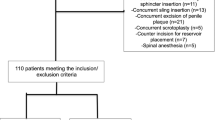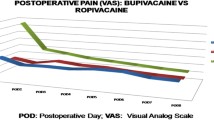Abstract
Purpose of Review
To review the most recent literature citing opioid-sparing multimodal analgesic strategies used to manage perioperative pain in patients who underwent inflatable penile prosthesis (IPP) surgery and to provide the penile implant surgeon a variety of non-opioid-based pain management strategies for IPP management.
Recent Findings
Interventions performed in the pre-operative, intraoperative, and post-operative arenas have all been shown to effectively lower pain scores and reduce opioid consumption. Certain surgical techniques performed during IPP surgery have helped with post-operative discomfort patients may feel after surgery. Multimodal analgesia (MMA) protocols adopted from other surgical fields and other urologic subspecialties that are implemented in IPP surgery have promising results with regard to post-operative pain control and opioid consumption.
Summary
Protocols that implement a combination of refined surgical technique and multimodal analgesia offer substantial benefit to patients undergoing IPP surgery. Further work is needed to assess long-term pain control and opioid use in patients that undergo IPP surgery using these innovative strategies.

Similar content being viewed by others
References
Papers of particular interest, published recently, have been highlighted as: • Of importance •• Of major importance
Jalal H, Buchanich JM, Roberts MS, Balmert LC, Zhang K, Burke DS. Changing dynamics of the drug overdose epidemic in the United States from 1979 through 2016. Science (80- ). 2018;361:1–6.
Alam A, Gomes T, Zheng H, Mamdani MM, Juurlink DN, Bell CM. Long-term analgesic use after low-risk surgery. Arch Intern Med. 2012;172(5):425–30.
Shah A, Hayes CJ, Martin BC. Characteristics of initial prescription episodes and likelihood of long-term opioid use — United States , 2006–2015. Morb Mortal Wkly Rep 2017;66(10):265–85.
Cabo J, Hsi RS, Scarpato KR. Postoperative opiate use in urological patients : a quality improvement study aimed at improving opiate disposal practices. J Urol. 2019;201(2):371–6.
Ellis JL, Ghiraldi EM, Cohn JA, Nitti M, Friedlander JI, Ginzburg S, et al. Prescribing trends in post-operative pain management after urologic surgery: a quality care investigation for healthcare providers. Urology. 2020; Accepted for publication.
• Reinstatler L, Shee K, Gross MS. Pain management in penile prosthetic surgery: a review of the literature. Sex Med Rev. 2018;6(1):162–9. This review discussing pain management strategies in penile prosthetic surgery was the first comprehensive review of the literature on the subject. It laid the groundwork for the present review with robust discussion of intraoperative interventions as well as the pathophysiology of penile pain.
Levine LA, Becher E, Bella A, Brant W, Kohler T, Martinez-salamanca JI, et al. Penile prosthesis surgery : current recommendations from the international consultation on sexual medicine. J Sex Med. 2016;13(4):489–518.
Jorissen C, De Bruyna H, Baten E, Van Renterghem K. Clinical outcome: patient and partner satisfaction after penile implant surgery. Curr Urol. 2019 Oct;13(2):94–100.
Pastuszak AW, Lentz AC, Farooq A, Jones L, Bella AJ. Technological improvements in three-piece inflatable penile prosthesis design over the past 40 years. J Sex Med. 2015;12(Suppl 7):415–21.
Trost L. Future considerations in prosthetic urology. Asian J Androl. 2020;22:70–5.
Welliver C. Optimizing outcomes in the virgin penile implant patient. Curr Urol Rep. 2019;20(3):14.
Griffith J, Valenzuela R. Pd22-02 long acting preoperative local anesthetic block to limit opioid administration after inflatable penile prosthesis insertion. J Urol. 2017;197(4S):e441.
Ziegelmann MJ, Joseph JP, Glasgow AE, Tyson MD, Pak RW, Gazelka HM, et al. Wide variation in opioid prescribing after urological surgery in tertiary care centers. Mayo Clin Proc. 2019;94(2):262–74.
Kehlet H. Multimodal approach to control postoperative pathophysiology and rehabilitation. Br J Anaesth. 1997;78(5):606–17.
Joshi GP, Schug SA, Kehlet H. Procedure-specific pain management and outcome strategies. Best Pract Res Clin Anaesthesiol. 2014;28(2):191–201.
Golladay GJ, Balch KR, Dalury DF, Satpathy J, Jiranek WA. Oral multimodal analgesia for Total joint Arthroplasty. J Arthroplast. 2017;32(9):S69–73.
Van Backer JT, Jordan MR, Leahy DT, Moore JS, Callas P, Dominick T, et al. Preemptive analgesia decreases pain following anorectal surgery: a prospective, randomized, double-blinded, placebo-controlled trial. Dis Colon Rectum. 2018;61(7):824–9.
Wick EC, Grant MC, Wu CL. Postoperative multimodal analgesia pain management with nonopioid analgesics and techniques: a review. JAMA Surg. 2017;152(7):691–7.
Sarakatsianou C, Theodorou E, Georgopoulou S, Stamatiou G, Tzovaras G. Effect of pre-emptive pregabalin on pain intensity and postoperative morphine consumption after laparoscopic cholecystectomy. Surg Endosc. 2013;27(7):2504–11.
Karaca O, Pınar HU, Turk E, Dogan R, Ahiskalioglu A, Solak SK. Effects of single-dose preemptive pregabalin and intravenous ibuprofen on postoperative opioid consumption and acute pain after laparoscopic cholecystectomy. J Investig Surg. 2019;32(3):189–95.
Mehta A, Hsiao W, King P, Schlegel PN. Perioperative celecoxib decreases opioid use in patients undergoing testicular surgery: a randomized, double-blind, placebo controlled trial. J Urol 2013;190(5):1834–8.
Ellis JL, Higgins AM, Simhan J. Pain management strategies in penile implantation. Asian J Androl. 2020;22:34–8.
• Raynor MC, Smith A, Vyas SN, Selph JP, Carson CC. Dorsal penile nerve block prior to inflatable penile prosthesis placement: a randomized, placebo-controlled trial. J Sex Med. 2012;9(11):2975–9. This well-designed randomized clinical trial was the first in the penile implant field demonstrating the efficacy of the dorsal penile nerve block in reducing pain in the early post-operative period.
Cotta BH, Welliver C, Brahmamdam A, Bednarchik CL, Dynda D, Köhler TS. Long-acting liposomal bupivacaine decreases inpatient narcotic requirements in men undergoing penile prosthesis implantation. Turkish J Urol. 2016;42(3):230–4.
Xie D, Nicholson M, Azaiza M, Gheiler V, Lopez I, Nehrenz GM, et al. Effect of operative local anesthesia on postoperative pain outcomes of inflatable penile prosthesis : prospective comparison of two medications. Int J Impot Res. 2018;30(3):93–6.
Brennan M, Suarez-Sarmiento A, Perito P, Gheiler E. 038 analgesic implant soaks with ropivacaine are as effective as perioperative penile blocks. J Sex Med. 2019;16(4):S18.
Rosero EB, Joshi GP. Preemptive, preventive, multimodal analgesia: what do they really mean? Plast Reconstr Surg. 2014;134(4):85S–93S.
Amid PK, Shulman AG, Lichtenstein IL. Local anesthesia for inguinal hernia repair step-by-step procedure. Ann Surg. 1994;220(6):735–7.
• Vollstedt A, Gross MS, Antonini G, Perito PE. The infrapubic surgical approach for inflatable penile prosthesis placement. Transl Androl Urol. 2017;6(4):620–7. This article discusses the technique and nuance of the infrapubic approach including the intraoperative techniques employed to reduce post-operative pain.
Candela JV, Hellstrom WJ. Three-piece inflatable penile prosthesis implantation: a comparison of the penoscrotal and infrapubic surgical approaches. J Louisiana State Med Soc. 1996;148(7):296–301.
Palmisano F, Boeri L, Cristini C, Antonini G, Spinelli MG, Franco G, et al. Comparison of infrapubic vs penoscrotal approaches for 3-piece inflatable penile prosthesis placement: do we have a winner? Sex Med Rev. 2018;6(4):631–9.
Karpman E. Streamlined approach for infrapubic placement of an inflatable penile prosthesis. Adv Urol. 2012;2012:3–7.
Lucas JW, Lester KM, Chen A, Simhan J. Scrotal reconstruction and testicular prosthetics. Transl Androl Urol. 2017;6(4):710–21.
Miranda-Sousa A, Keating M, Moreira S, Baker M, Carrion R. Concomitant ventral phalloplasty during penile implant surgery: a novel procedure that optimizes patient satisfaction and their perception of phallic length after penile implant surgery. J Sex Med. 2007;4(5):1494–9.
Chason J, Sausville J, Kramer AC. Penile prosthesis implantation compares favorably in malpractice outcomes to other common urological procedures: findings from a malpractice insurance database. J Sex Med. 2009;6(8):2111–4.
Gromatzky C. Opinion: why I prefer the penoscrotal access. Int Braz J Urol. 2015;41(3):410–1.
Wilson SK, Aliotta PJ, Salem EA, Mulcahy JJ. New enhancements of the scrotal one-incision technique for placement of artificial urinary sphincter allow proximal cuff placement. J Sex Med. 2010;7(10):3510–5.
Brennan M, Suarez-Sarmiento A, Suarez-Sarmiento A, Gheiler E, Perito P. 283 midline reservoir placement via the infrapubic approach: an excellent option in patients with previous bilateral inguinal surgery. J Sex Med. 2019;16(4):S134–5.
Schwenk ES, Mariano ER. Designing the ideal perioperative pain management plan starts with multimodal analgesia. Korean J Anesthesiol. 2018;71(5):345–52.
Ben-David B, Nelson JB, Chelly JE, Chairman V. Multimodal analgesia for radical prostatectomy provides better analgesia and shortens hospital stay. J Clin Anesth. 2007;19(4):264–8.
Matulewicz RS, Patel M, Jordan BJ, Morano J, Frainey B, Bhanji Y, et al. Transversus abdominis plane blockade as part of a multimodal postoperative analgesia plan in patients undergoing radical cystectomy. Bl Cancer. 2018;4(2):161–7.
•• Tong CMC, Lucas J, Shah A, Foote C, Simhan J. Novel multi-modal analgesia protocol significantly decreases opioid requirements in inflatable penile prosthesis patients. J Sex Med. 2018;15(8):1187–94. This study introduces the first multimodal analgesia protocol used in penile prosthetic surgery and demonstrated its benefit in reducing post-operative pain and opioid usage.
•• Lucas J, Gross M, Yafi F, DeLay K, Christianson S, El-Khatib FM, et al. A multi-institutional assessment of multimodal analgesia in penile implant recipients demonstrates dramatic reduction in pain scores and narcotic usage. J Sex Med. 2020;17(3):518–25. This multi-institutional investigation validates the above multimodal analgesia protocol, confirming its safety and benefit in patients undergoing penile implant surgery.
Gridley C, Robles J, Calvert J, Kavoussi N, Winkler T, Jayaram J, et al. Enhanced recovery after surgery protocol for patients undergoing ureteroscopy: prospective evaluation of an opioid-free protocol. J Endourol. 2020;34(6):647–53.
Author information
Authors and Affiliations
Corresponding author
Ethics declarations
Conflict of Interest
Dr. Ellis, Ms. Pryor, Dr. Mendez, and Dr. Suarez-Sarmiento, Jr. have no conflicts of interest to disclose.
Dr. Simhan and Dr. Perito are consultants for both Boston Scientific and Coloplast.
Human and Animal Rights and Informed Consent
All reported studies/experiments with human or animal subjects performed by the authors were performed in accordance with all applicable ethical standards including the Helsinki declaration and its amendments, institutional/national research committee standards, and international/national/institutional guidelines.
Additional information
Publisher’s Note
Springer Nature remains neutral with regard to jurisdictional claims in published maps and institutional affiliations.
This article is part of the Topical Collection on Men’s Health
Rights and permissions
About this article
Cite this article
Ellis, J.L., Pryor, J.J., Mendez, M. et al. Pain Management Strategies in Contemporary Penile Implant Recipients. Curr Urol Rep 22, 17 (2021). https://doi.org/10.1007/s11934-021-01033-1
Accepted:
Published:
DOI: https://doi.org/10.1007/s11934-021-01033-1




